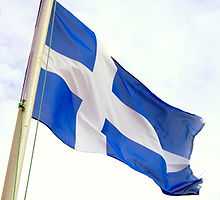Flag of Shetland
 | |
| Use | Civil flag |
|---|---|
| Proportion | 3:5 (5:2:5, 5:2:13) |
| Adopted | 1969 |
| Design | A white Nordic cross on a blue field |
| Designed by | Roy Grønneberg & Bill Adams |

The flag of Shetland was designed by Roy Grønneberg and Bill Adams in 1969. It was unofficially created to commemorate the 500th anniversary of the transfer of the islands from Norway to the Kingdom of Scotland and the 500 years before as part of Norway.[1]
It was recognised by the Lord Lyon, the heraldic authority of Scotland, on 1 February 2005,[2] just in time for the Island Games in July 2005 in Shetland.[3] The flag was officially adopted with a description by the Shetland Islands Council (SIC) on 13 December 2006. It was at the same time stated that the proportions were to be 3:5 with the fields to the hoist being square as in the flags of Norway, Iceland and the Faroes. Before 2006 the fields to the hoist had commonly been rectangular. The width of the bars is 1/6 the height of the flag. This creates proportions of 5:2:5, 5:2:13.
The flag uses the colours of the flag of Scotland, but in the form of the Nordic cross in order to symbolise Shetland's historical and cultural ties with the Nordic region. The colours and device are the inverse of that of flag of Finland.
It is widely used privately by Shetlanders both on land and sea. The flag is now seen as a symbol of the special Shetland identity.
In 2007 a Shetland Flag Day was introduced on Midsummer Day, 21 June. The SIC hopes the day will be used to "celebrate all things Shetland".[4]
The flag is practically identical to the former unofficial national flag of Iceland (the Hvítbláinn) in use by Icelandic nationalist activists from 1897 until 1915, when it was in part abandoned due to its similarity to the Greek jack and the Swedish flag, which critics reasoned would be hard to tell apart at sea, a major issue in a time of war. The white and blue is still used by the Icelandic Youth Association.
References
See also
- Flag of Scotland
- List of Scottish flags
- Nordic Cross Flag
| ||||||||